EXCLUSIVE ARTICLE |
||
|
||
EXCLUSIVE ARTICLE |
||
|
||
|
|
||||
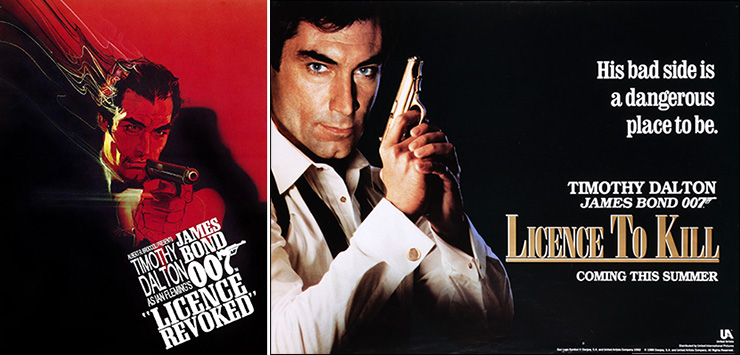 |
||||
|
“His bad side is a dangerous place to be” |
||||
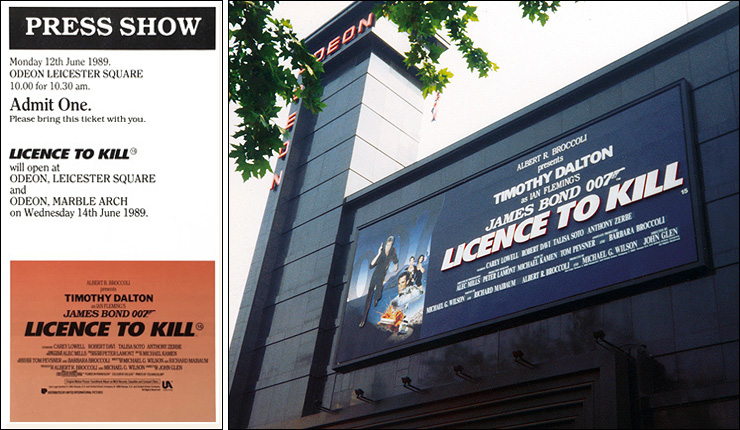 |
||||
|
Licence To Kill was first screened for the press at the ODEON Leicester Square on the morning of Monday June 12, 1989, the day before its Royal World Charity Premiere. The screening was attended by co-producers Albert R. Broccoli and Michael G. Wilson (who co-wrote the screenplay with Richard Maibaum). The occasion also marked the launch of the first edition of Graham Rye's book The James Bond Girls. |
||||
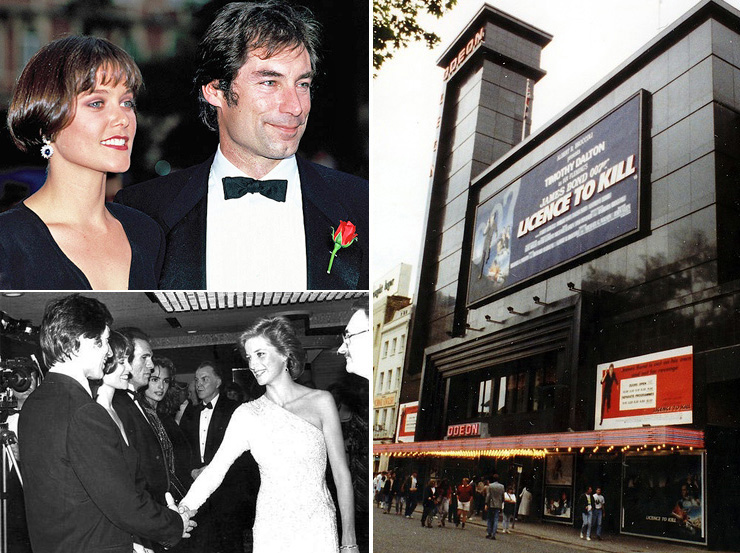 |
||||
|
||||
|
Licence To Kill also had an identity crisis when it came to the marketing of the film. Before the title change from ‘Licence Revoked’, a series of stylish early teaser posters designed by Bob Peak (who painted the striking poster artwork for The Spy Who Loved Me in 1977) were rejected, and other artists including Tom Jung and Stephen Chorney coming up with concept artwork capture the new style of realism the producers were trying to achieve. Eventually Licence To Kill was released with a photo-montage poster designed by Robin Behling, which featured the first depiction of James Bond without the traditional tuxedo and bowtie. Although reviews were generally positive, the box-office for Licence To Kill was disappointing, particularly in the US where it was released against Batman, Lethal Weapon 2 and Indiana Jones And The Last Crusade, which featured a scene-stealing performance by original 007 Sean Connery as Dr. Henry Jones. |
||||
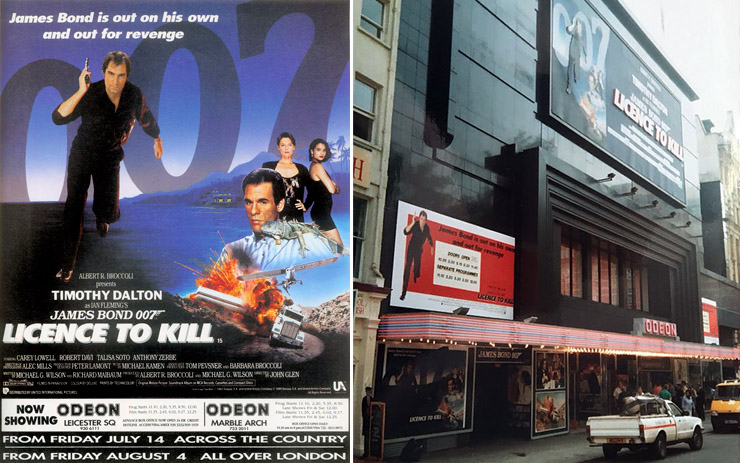 |
||||
|
Licence To Kill ended its ten-week West End engagement at the ODEON Leicester Square on Thursday August 24, 1989. The same day also saw Licence To Kill finish its concurrent ten-week run at the ODEON Marble Arch, which had originally been home to the largest cinema screen in the country, and was the primary venue for the presentation of 70mm films in London. The original massive curved screen (75 feet wide X 30 feet high) was removed in May 1989 and a somewhat flatter screen installed. This was done at the request of Sir David Lean to allow for a less distorted view of the desert skylines in the restored directors cut of his epic Lawrence of Arabia (1962). Licence To Kill had replaced the exclusive West End 70mm presentation of Lawrence of Arabia at the ODEON Marble Arch, and therefore played on the new flatter screen. On Friday August 18, 1989, Licence To Kill opened at the Plaza 1, off Piccadilly Circus where it played for six-weeks before transferring to the smaller 378-seat Plaza 2 for one week from Friday September 29th. The film then spent a further two-weeks at the 181-seat Plaza 3, followed by another five-weeks at the 163-seat Plaza 4 from Friday October 20, 1989. Licence To Kill was then booked for an exclusive return engagement at the Plaza, playing for four-weeks at Plaza 4 from Friday December 22, 1989, and a final week in Plaza 3 from Friday January 19, 1990. Just a month later Licence To Kill made its debut on VHS video in the UK, but many die-hard Bond fans chose to import the Dutch edition which was not subjected to BBFC censorship. |
||||
 |
||||
|
The relatively disappointing box-office returns for Licence To Kill led producer Albert R. Broccoli to question the viability of the series, and in August 1990 put DANJAQ, the company which held the James Bond film copyright, up for sale. Not since 1975 and the split with Harry Saltzman, did the future of the Bond series look to be in serious doubt. Timothy Dalton said at the time “My feeling is this will be the last one. I don't mean my last one, I mean the end of the whole lot. I don't speak with any real authority, but it's sort of a feeling I have”. Then distributors MGM/UA were having their own financial problems and it took until 1993 for the legal issues to be resolved. Broccoli appointed his daughter Barbara alongside stepson Michael G. Wilson as producers at EON Productions, while he concentrated on matters at DANJAQ. During this hiatus period James Bond fandom began to grow in strength in the UK and USA. The wider availability of the films on video and laserdisc meant the series came under closer scrutiny than ever before, and the Sean Connery/George Lazenby era in particular was being re-evaluated by fans. However, it was now much harder to see these earlier films on the big screen and with an audience. Two ground-breaking James Bond fan conventions held in London in 1981 and 1982 had relied on poor quality 16mm versions. |
||||
 |
||||
|
“James Bond Back at the National Film Theatre” |
||||
 |
||||
|
Both director Terence Young and main title designer Maurice Binder addressed the audience before the screening of Thunderball, with Young commenting on his annoyance at the difficulty experienced in obtaining a screenable print of the film. In 1985 producer Albert R. ‘Cubby’ Broccoli had presented a set of brand new prints of the James Bond films to the Museum of Modern Art in New York to coincide with an exhibition of Bond props; but it would be another six years before a set of five new prints were made available to the British Film Institute, with a further three added to the archive in 1997. |
||||
|
||||
|
Following the success of the Thunderball screening, The James Bond 007 Fan Club then arranged a special double-bill of You Only Live Twice/On Her Majesty's Secret Service at the National Film Theatre on the afternoon of Saturday February 22, 1992. Once again, Graham Rye invited special guests to the screening including On Her Majesty's Secret Service (1969) production designer Syd Cain, stunt arranger George Leech, and Wing-Commander Ken Wallis, designer and pilot of the autogyro ‘Little Nellie’ seen in You Only Live Twice. |
||||
|
||||
|
The double-bill was once again screened to an enthusiastic sell-out audience at the NFT1 and proved that although the films were popular as sell-through VHS videotapes, the only place to really experience their Panavision splendour was on the big screen. |
||||
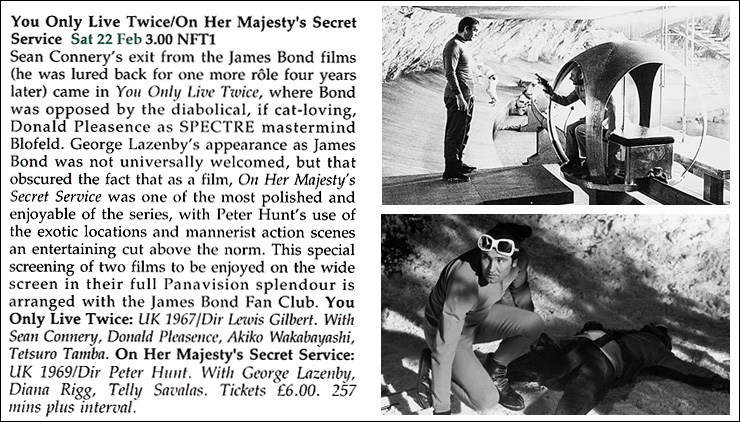 |
||||
|
“Bond at the BBC” |
||||
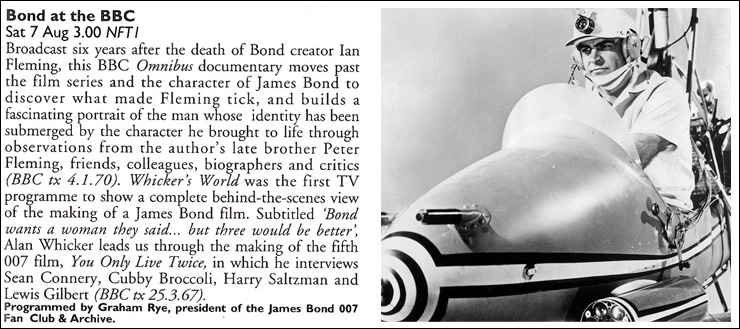 |
||||
|
Until the triumphant return of 007 to the big screen in November 1995, these fan-organised events were the only way to see the James Bond films in a cinema environment, and then only in London for a small number of dedicated fans and audience members who made the effort to attend the special one-off screenings. |
||||
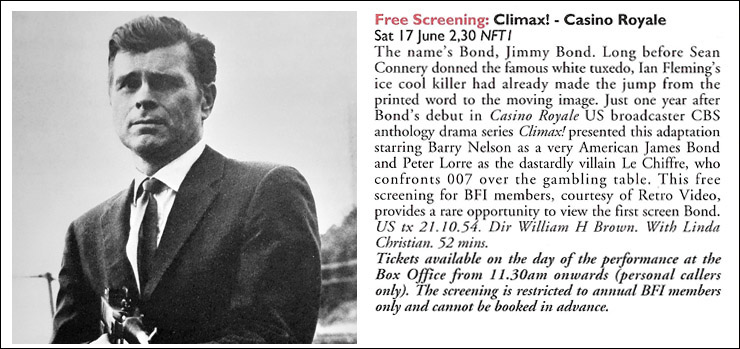 |
||||
|
Although not technically a James Bond film as it was made for and screened on US Television on October 21, 1954, Casino Royale (part of the anthology series CLIMAX!) did mark the first appearance of Ian Fleming's creation outside of the published novels. The live TV broadcast was largely forgotten until its rediscovery in 1981 (as exclusively reported in detail in 007 MAGAZINE issue #18 – Autumn 1988) and relatively unknown to UK audiences until its 1995 release on VHS by Retro video. The National Film Theatre arranged for a free screening of the one-hour show on Saturday June 17, 1995. As the source material was available as 16mm film, the show was screened in NFT1 and tickets were restricted to British Film Institute annual members only. The screening was therefore very exclusive as tickets could only be obtained three hours before the programme started at 2.30pm. The original Kinescope recording of Casino Royale was made by pointing a camera at a TV screen, so the resultant image was of poor quality and geometrically distorted. The original 16mm version discovered in Chicago by film and TV historian Jim Schoenberger was missing the final 2½-minutes which included the final confrontation between Jimmy Bond (Barry Nelson), Valerie Mathis (Linda Christian) and Le Chiffre (Peter Lorre). Also missing was the on-screen appearance of show host, William Lundigan, and the original end credits. The version shown at the National Film Theatre and originally released on VHS was the truncated version. This version was later included as an extra on the MGM DVD release of Casino Royale (1967). The missing minutes were discovered some years later and included in a video release from the US collectables company Spyguise. |
||||
 |
||||
|
|
||||